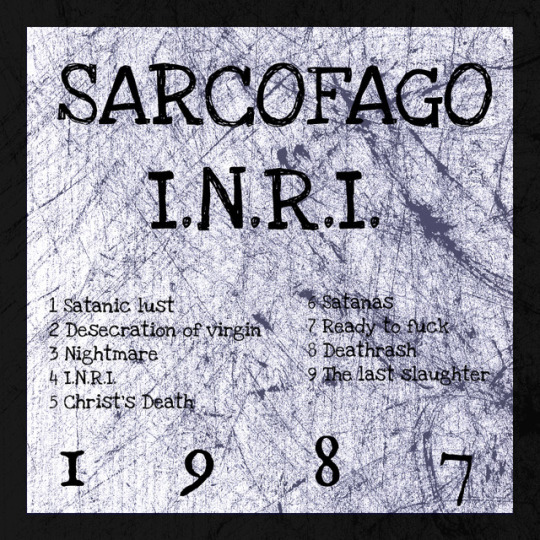#INRI CLASSIC
Explore tagged Tumblr posts
Text

Alonso Cano (Spanish, 1601-1667) Cristo crucificado, 1646 Real Academia de Bellas Artes de San Fernando
#Alonso Cano#1600s#art#fine art#european art#classical art#europe#european#fine arts#oil painting#europa#mediterranean#spanish art#spanish#spain#iberia#iberian#hispanic#latin#christian art#christian#christianity#christentum#the crucifixion#crucifixion#Jesus Christ#Son of God#God the Son#INRI
51 notes
·
View notes
Text
Fun Fact! Crosses!
I am not around, this is a queued Fun Fact! Don't send me requests! I won't see them!
Easter is coming up, so let’s talk about different kinds of crosses! You’ve probably seen most of these before, especially if you’re Catholic, but maybe you didn’t know the names!
Of course, most Christians are familiar with the Latin Cross:

That’s the classic one, of course.
The Greek Cross, with equal lengths on each bar:

Also a classic!
The Patriarchal Cross, which you see a lot in Orthodox churches:

The extra bar towards the top represents the ‘INRI’ sign Pilate posted on the Cross.
The Papal Cross:

I’m not actually sure what the deal with that one is.
The Chi Rho:

This takes the two Greek letters, ‘Chi’ and ‘Rho’ (first two letters of ‘Christos’ in Greek), and combines them.
The Jerusalem Cross, used in the Kingdom of Jerusalem in the Crusades:

I *believe* it represents how Jerusalem was believed to be the center of the world, and the crosses in the corners represent the four corners of the world? I think, anyhow.
The Tau Cross:

Also called Saint Anthony’s Cross, as it’s associated with Saint Anthony of Egypt. It’s also got Franciscan associations!
Cross of Saint James:

Big in Spain, obviously, where Saint James the Greater is quite popular. It’s the symbol of the Order of Santiago (Saint James).
Celtic Cross, which you see a lot in Irish stores as knick-knacks, though they’re also from Scotland and Wales:

Obviously modeled after those stone crosses you’ll see carved in the British Isles.
The Ankh, which Coptic Christians sort of grabbed from Egypt:

This was originally an Egyptian symbol for ‘life’, unrelated to the Cross as we know it in the original context.
The Maltese!

The symbol of the Knights of Saint John and the Order of Hospitallers! And obviously, the island of Malta.
And the Marian Crosses:


It combines the Latin Cross with the letter ‘M’, to emphasize how Mary was at the Crucifixion.
Hope this was something that you didn’t know!
121 notes
·
View notes
Note
In that case could you possibly compile an introductory list to what you would consider good black metal for someone coming more from hardcore (i also listen to some metal but nothing really specific as a genre)? Thank you for your previous answer
sorry this took so long anon! i wanted to really give some specific recs, especially considering you sound less familiar with the metal basics. hopefully you find some good stuff worth exploring!
first and foremost, i would recommend first wave black metal pretty wholeheartedly for punk/hardcore fanatics. First wave essentially refers to the 80s black metal that existed pre-scandinavian genre definition (which means its also less sketch, typically, though there are shitheads). This stuff is pretty nebulous, its defined mostly by "extremity" and genre mixing (stuff that existed on the outskirts of other genres, with different balances of black/death/thrash). A lot of it is influenced by thrash and punk + it was way underground so shares a lot of qualities with diy/shit production + was primarily made by teens and people who could barely play their instruments. some essentials:
Venom - Welcome to Hell (defining black metal influence even if the sound of black metal is unrecognizable now. punk influence in spades, if you like discharge you'll love this)
Bathory - Under the Sign of the Black Mark (if venom is what really codified Satanism in bm, then bathory did the same for vikings. this is probably The Classic first wave rec)
Slayer - Show No Mercy (barely counts here, but they rip off venom enough and this is impactful enough that if you haven't gotten to it, this is required listening)
Celtic Frost - Morbid Tales
Sarcofago - INRI
Sodom - In the Sign of Evil (much more on the thrash side of first wave, Sodom was pushing enough boundaries that they've been incorporated into the first wave)
Bulldozer - The Day of Wrath (blackened thrash with a ton of venom/motorhead influence)
Mortuary Drape - All the Witches Dance
there's also a long tradition of black punk crossover. ultimately the genres have ideological similarities in terms of their philosophies surrounding music imo (not politically, obviously) and how it manifests as its own self-perpetuating diy culture. black/punk tends to also be less full of shitheads, which is nice
Devil Master - Satan Spits on the Children of Light
Melissa - Melissa
Truchlo Strzgi - Gwiezdny Demon
Gehennah - Hardrocker (tw for puke on the cover btw)
Wildspeaker - Spreading Adder (black and crust infusion here, rather than just punk)
Svalbard - When I Die, Will I Get Better? (technically my blackgaze rec, I think it's tempered significantly by the post-hardcore influence, it feels much more intense and varied)
in terms of true blue kvlt black metal, here's a nebulous collection of bands I'd suggest checking out since they're more along what i see hardcore heads gravitate towards and then you can dig deeper into their respective scenes/niches
Darkthrone (first couple classics have the greatest diy charm of the second wave imo. later work incorporates a lot of punk, they experiment with crust and trad and such)
Immortal (think the fact immortal seem very ridiculous and over the top makes them very endearing to people who otherwise dislike the self-serious nihilism of the second wave)
Rotting Christ
Panopticon
Gabestok
Hulder
Tietanblood
Havukruunu
as a final note, I'll just mention Opera IX, Spectral Wound, Yaotl Mictlan, Valdrin, Tresspasser, Dawn's Reflection, Thantifaxath, and Marthe for some bands i really like that are less accessible for hardcore listeners (mainly use symphonic elements like synths and keys or are atmospheric in an opposite direction to blackgaze)
#tried to keep it as sketch-free as possible here. obv darkthrone it depends person-to-person#but everyone learning more about black metal really needs to familiarize themselves with Some norweigian second wave and theyre the cleanes#but anyway. hopefully this is a good starting point for you!!#anon#igottheanswer#my posts
9 notes
·
View notes
Text
Timeless Symbol: 14K Gold INRI Classic Crucifix – Europa Jewelers
Display your devotion with the Solid 14K Gold INRI Classic Crucifix EJCR27921. Crafted with deep reverence in 14K yellow gold, this traditional crucifix features the INRI inscription and stunning details. A staple for anyone looking to wear or gift a piece of enduring spiritual significance. 📧 Email: [email protected] 📍 Address: Europa Jewelers, Downtown Los Angeles - The Jewelry District, 607 South Hill Street, Los Angeles, CA 90014 USA
0 notes
Text
Agnese Contini: "Desert Earth" è il nuovo video
E’ online il video di Desert Earth (INRI Classic / Universal Music Italia), il nuovo brano della chitarrista salentina Agnese Contini. Il video, girato da Chiara Vantaggiato nei pressi di Lecce (tra Tricase Porto e la Cava di Bauxite di Otranto), mostra uno scenario di desolazione e totale inaridimento terrestre. Immerso tra toni caldi e terreni aridi, le immagini del video concretizzano il…
#agnese contini#desert earth#emergenti#genere musicale#musica indipendente#trakoftheday#video#youtube
0 notes
Text
Torso Virile Colossale - Concerto Trionfale
Giovedì 11 gennaio 2024 I Distratti presentano Concerto Trionfale di TORSO VIRILE COLOSSALE, uno speciale live audiovideo eseguito al Teatro Oscar da un Ensemble Titanico per festeggiare la fine del tour iniziato un anno fa con la pubblicazione del secondo album MONDO PEPLUM edito da INRI Classic. TORSO VIRILE COLOSSALE è l’originale progetto musicale dedicato al Cinema Peplum creato da…

View On WordPress
0 notes
Photo

3 notes
·
View notes
Photo

«Study after detail from Hans Holbein the younger’s ‘The Body of the Dead Christ in the Tomb’» 12 x 18 cm Oil on gesso primed cardboard #painting #oilpainting #oilpaint #masterstudy #mastercopy #renaissanceart #renaissancepainting #classical #classicalpainting #arthistory #christ #christianart #eccehomo #inri #rexiudaeorum #stigmata #nottodaysatan #hansholbein #handholbeintheyounger https://www.instagram.com/p/CPERGgOp9KV/?utm_medium=tumblr
#painting#oilpainting#oilpaint#masterstudy#mastercopy#renaissanceart#renaissancepainting#classical#classicalpainting#arthistory#christ#christianart#eccehomo#inri#rexiudaeorum#stigmata#nottodaysatan#hansholbein#handholbeintheyounger
0 notes
Note
🥃 (i think this is the right emoji) THIS ONE GOES OUT FOR ALL OF THEM BC ITS AN INTERESTING QUESTION ‼️
WHATS UP SLIME
🥃: If your OC was in this universe, what would be their favourite show/book/band/social media platform?
For Viola. . .
Viola pre-embrace was really into classic Goth music, like Bauhaus! Afer her embrace however she had a big shift in personality and traits and she'd probably prefer black metal--growling and all. Some things in common between her life and unlife though would be her love for books (she's got a collection of books on occult knowledge, gothic romance, horror and thrillers, and also issues of The Sandman comic by Neil Gaiman). She did not grow up with a computer nor a TV in her house (her neighbors had a TV but she did not really care) so I don't think she'd really be into TV nor social media.
For Art. . .
Art is very much into alt-rock (a la Incubus or APC? which is more like hard rock) and classic Pinoy rock and other tunes, like Eraserheads or APO Hiking Society. At home, he's also usually playing reggae or traditional Filipino music while painting or some shit. He is not into reading and barely has access to books but he really loved Franz Kafka's "Metamorphosis," which he read as a teenager (it resonated with him being trans PLEASE). He used to be really into LiveJournal and had his own website where he'd post about his college projects and personal life--nowadays though he doesn't care for social media. If he had a computer he'd just watch YouTube rips of Jackass. His favorite shit to watch on TV was Nickelodeon and Animal Planet/National Geographic.
For Carmensita. . .
Carmensita is THE goth girl and music nerd of the group. She loves the classics, gothic rock, gothic metal, and more. If you hear some shit like "I Don't Wanna Be Me" by Type O Negative echoing through the warrens--that's how you know she's home. She hates reading long swathes of text, it's difficult for her and gives her a headache, so she doesn't read for fun... though she does ike reading blog posts and random shit people write on the Internet. She would be an avid Tumblr user I just know it. She also loved watching random bullshit on MTV; trashy reality TV is PRIME ENTERTAINMENT for her.
For Alin. . .
Alin loves house music SO much. Walking down the runway this shit is what's on her mind. She's got a nice audio setup and everything... the hybrid CD and casette tape player is her baby. This girl loves written art... she keeps many poetry books, novellas, short stories, and more in her home--most pertaining to themes of change, romance, and transness. She's also got lots of art and photography books. She would ABSOLUTELY be an Instagram user in this day and age oh my god. She also did not grow up with a computer and never had to use one until she came to the USA, but she loves being able to share her life and work with people and sees social media as a tool for this. Her favorite shit on TV would be classic Pinoy teleseryes (soap operas), public access television, world culture shows, etc.
Out of the other OCs; Booc (Tzimisce) and Buot Buktot (Baali, Viola's Sire) are kind of archaeic beings that have forgone worldly pleasures outside of carnal shit. THey would probably be into each other by the way. With Pusakal (Gangrel), although he definitely seems like something of a little vagrant who'd be into regular people shit, he's a bit of an enigma and really just prefers being a wild cat who eats people. He really actually just sleeps in trees and is small enough such that people don't really notice him up in the canopies you get me.
2 notes
·
View notes
Text
One of the more middling rounds on average, mostly just due to some vaporwave dross. Some amazing stuff here too, though, some of the best i’ve heard from this project.
Alec Empire- The Destroyer (8.5/10)
Arca- &&&&& (8.0/10)
Bessie Jones with the Georgia Island Singers- Get in Union: Recordings by Alan Lomax 1959-1966 (10/10)
Blasphemy- Fallen Angel of Doom... (8.0/10)
BT- This Binary Universe (8.5/10)
Califone- Insect Courage (7.0/10)
Carl Craig- More Songs About Food and Revolutionary Art (7.5/10)
Cat Power- Moon Pix (9.0/10)
Cloud One- Atmosphere Strut (9.0/10)
Coakira- Suicidegirls.jp (7.5/10)
CyanBlue- Cyantology (7.0/10)
Darkthrone- Under a Funeral Moon (9.5/10)
Deepchord- dc07/dc08/dc09 (8.0/10)
desert sand feels warm at night- 0:21(8.5/10)
Eco Virtual- ATMOSPHERES 第2 (7.0/10)
Future Girlfriend- Pink Dance EP ピンクのダンス (8.5/10)
Gastr del Sol- Crookt, Crackt, or Fly (7.5/10)
Genghis Tron- Board Up the House (8.5/10)
Godflesh- Pure (7.0/10)
GUDSFORLADT- Guilt. (8.0/10)
haircuts for men- 壊滅悲しみ (8.0/10)
Howlin' Wolf- The Howlin' Wolf Album (7.0/10)
Isis- Panopticon (8.5/10)
Ital- Hive Mind (8.5/10)
Jandek- Ready for the House (8.5/10)
Jason Molina- Autumn Bird Songs (8.0/10)
Jesu- Infinity (6.5/10)
Johnny Cash- I Walk the Line (7.0/10)
Jungle Fever- Vaporwave Drum and Bass (5.5/10, deleted from library)
Laserdisc Visions- New Dreams Ltd. (8.5/10)
Lemon Jelly- Lost Horizons (7.5/10)
Limousine- Omega Mall X (7.0/10)
Lindstrøm- Smalhans (7.5/10)
Local News- Ghost Broadcast (7.5/10)
Luxury Elite- New Classics (6.0/10, deleted from library)
Maitro- 24Hrs. (7.0/10)
Make a Change... Kill Yourself- Make a Change... Kill Yourself (8.0/10)
Master's Hammer- Ritual (9.0/10)
Mayhem- Live in Leipzig (4.5/10, keeping for historical importance and maybe to revisit later but holy shit do i not like Dead’s vocals and they’re SO FUCKING LOUD)
Merle Haggard- Mama Tried (9.5/10)
Ministry- The Mind is a Terrible Thing to Taste (8.0/10)
Miranda Lambert- Platinum (7.5/10)
Monolake- Gravity (8.0/10)
Mountain Man- Made the Harbor (7.0/10)
Neil Young- Harvest (8.5/10)
Neko Case- Blacklisted (9.0/10)
Nile- Amongst The Catacombs Of Nephren-Ka (8.0/10)
Orbital- Orbital 2 (8.5/10)
Recondite- On Acid (8.0/10)
Sarcófago- INRI (7.5/10)
shimmer- In Translation (6.0/10, deleted from library)
Sunn O)))- 观世音 Kannon (8.5/10)
Trentemøller- The Last Resort (9.5/10)
Unsane- Total Destruction (8.0/10)
Vektroid- Neo Cali (8.5/10)
Venom- Black Metal (8.5/10)
16 Horsepower- Folklore (7.0/10)
8GB- Amiga Acid Mixtape Vol. 1 (7.5/10)
夢のチャンネル- あなたのために (5.5/10, deleted from library)
👁🗨📲- 01-999-6363 拨号上网 sexxxline (8.5/10)
4 notes
·
View notes
Text
DIMAIO: il sorprendente esordio discografico dell’unico controtenore barocco alla corte dell’elettronica Nordeuropea
S’intitolerà “Debut” e sarà disponibile a partire dal prossimo 5 maggio in formato fisico e digitale l’opera prima del controtenore DiMaio. (more…)
View On WordPress
0 notes
Note
hii if u don't mind, any metal bands you'd recommend for someone wanting to get into slightly more obscure stuff but doesn't know where to start digging? any subgenre/time period idc. asking u this bc i trust ur knowledge
i truly truly love getting asks like this, thank you for trusting me and it's awesome to hear you want to dig deeper!!
it's hard for me to give specific recs because i don't know what you've vibed with so ill meet you half way and give you a list as well as some places to learn more just in case i end up in the wrong direction.
these are some bands that clicked for me when i was first exploring outside my comfort zone, as well as some stuff from my aoty from the last few years:
Possessed - Seven Churches; this one is the least obscure but i feel like possessed are easy to miss. important band bridging the gap between thrash and death metal. love crazy maniac shit like this
Satan- Court in the Act; classic new wave of british heavy metal with a bit of edit. type of band that had enormous pull in underground power and speed metal scenes- this is a blueprint for a lot of great obscure heavy metal with the soaring vocals and the tappy solos. i love chastain (american, mid/late 80s response) if you want to see that lineage in effect
Mystifier - Goetia; brazilian metal is a huge huge historically important metal phenomenon. sepultura are more well-known and sarcofago are cult classic black metal pioneers (seriously, inri is one of the greats) but mystifier is a band that opened up the scene for me a little more and is incredible in their own right
Autopsy - Metal Funeral; slow, gripping death metal carnage!! also one of the few legacy bands continuing to release actual good music which is fun. also, if you like the autopsy you'll love derketa, dream death, mythic, winter, all of whom make their own twist on a similar crushing brand of doomy death metal goodness
Sabbat- Envenom; long-running old-school japanese black metal. has that thrashy-punk first wave flavor along the lines of celtic frost, root, bulldozer (also sarcofago) and sodom at their most brutal.
Sacrilege- Behind the Realms of Madness; crusty thrash that had a huge influence on early bolt thrower. good if you're into punk already and want more of that in the metal (their later records lose the crust but gain doom- I almost like them more. killer band)
Vastum. any of their records seriously maybe the best active band on the planet rn.
Warning- Watching from a Distance; if you got to metal through my mcr blog then i think you can handle the whiny vocals on this and get a legit transformative experience out of Warning. seriously love this album, delightfully heavy doom in an emotional package. and doom is easy to rec, satisfying and not to extreme: Pentagram, Candlemass, Trouble, and Saint Vitus are all must must listens
Chevalier- Destiny Calls; combination of speed and power i really love in the classic heavy metal fantasy and knights vein. newer band too with a lot of similar listening to bigger bands in that scene. and if you like this style at all manilla road (the band) is a requirement if you aren't already familar
Some eclectic newer stuff I've enjoyed lately: Vicious Blade, Tyrann, Reverend Bizarre, Nekromantheon, Firmament, Svalbard, Vampirska, Ares Kingdom, Messa
but i really recommend checking out r/metal- their essentials is good for a beginner but they also have a ton of primers that can give you overviews of niche genres. the fenriz metal spotify playlist is also fuckin killer. For new music, look into reviews from sites like angrymetalguy, no clean singing, heavy blog is heavy, invisible oranges. helpful to know how your taste aligns with the writing staff (like i know if angrymetalguy dislikes something, im almost guaranteed to like it). shreddit has a release tracker on spotify; there's also a constant update of new releases on the metal archive!
#big black metal gap i just realized lmaooo sorry not something id willynilly rec w/out knowing someones personal limits re artist and ethics#but hopefully this give you some stuff to chew on!!!#and im always open to this kinda thing if someone wants to send an ask or dm or anything- ill do what i can!#my posts#igottheanswer#anon#music recs
8 notes
·
View notes
Text
What the fuck is the hexagram ritual?: a guide
By reader request, welcome to the sequel to my guide on ‘What the fuck is the LBRP?’, taking you from a five to a six (Thelemites will appreciate the numerology there). I answer a less-asked but still equally common question: what the fuck is the hexagram ritual?

Recalling that the pentagram is a star with five points, the hexagram is one step up from that, a star with six points (d’oh). In the classic Western paradigm, while the five points of the pentagram represent the elements (including Spirit), the points of the hexagram are typically understood to represent the seven classical planets—
Wait, how the hell do seven planets fit into six points?
—I’m getting there. The six points represent (in clockwise order from top, based on the Golden Dawn/Thelemic schema) Saturn, Jupiter, Venus, the Moon, Mercury, and Mars, while the Sun is represented by the centre of the hexagram.
Hence the hexagram and the pentagram generally work on two different levels: the elements making up the pentagram are right here, with us, in this material realm. The hexagram, representing the planets, are out there, floating in the great inky space that lies beyond.
In other words, the pentagram primarily represents our microcosm: the hexagram, the macrocosm.
Okay, who made that shit up?
Probably the Golden Dawn. Ish.
This assignation of the points isn’t arbitrary: the modern Hermetic Kabbalah assigns planets (including the modern ones, i.e. Uranus, Neptune and Pluto – yes, Pluto) or the Sun or the Moon to each of the Sephiroth, or spheres on the Tree of Life.
The Tree of Life?
It’s hard to explain Hermetic Kabbalah concisely and satisfactorily here, so I’d recommend a book such as Lon Milo DuQuette’s The Chicken Qabalah of Rabbi Lamed ben Clifford. In essence, the Kabbalistic Tree of Life is a diagram that visually represents the ten spheres (the Sephiroth) that embody the process of how creation emanates from the original Source, i.e. God with a really big G. Imagine a light shining through ten different filters, the last of which crystallises it into the thing we perceive as Creation.
It’s probably easier to show you:

Do you see the hexagram in the middle of the Tree, centred around Tiphareth/the Sun? That’s exactly where the hexagram correspondences come from.
I thought you said ten spheres – why are there eleven? Also, Uranus is at the top point, not Saturn.
... because Daath (‘Knowledge’), the sphere to which Uranus is assigned, isn’t a ‘real’ sphere, so to speak. The theory is rather more than this primer can cover, but in short, Daath is more of an ‘illusory’ state that sits right on the gap between the spiritual consciousness attainable by humanity (culminating at Chesed) and the ‘pure’ Divinity that lies beyond the veil separating us from the source of all things. This is the gap known as the Abyss, and is a trap for any spiritual seeker. The next 'real' Sephirah after Daath is Binah, which in Thelemic cosmology is also the seat of Babalon, the Great Mother, who assists us safely beyond the Abyss. This is why Saturn takes the top point where Daath should be – it’s the culmination of the journey over the Abyss.
The Earth isn’t included in the correspondences, because the Earth is a given: we have our foot planted firmly in Malkuth, the realm of physical manifestation, of this tangible world around us. This is where the four classical elements live, and where we are. It is from here that we have a base from which to manipulate the six spheres above us, and being rooted here ensures that the higher influences in our lives are balanced, pleasant and stable.
So how does the hexagram ritual fit into all of this?
Easy-peasy: just as the LBRP is our key ritual to balancing and harmonising the influences of the four elements in our life, the hexagram ritual is our key to accessing the power of the macrocosmic forces of the planets.
I’m not actually going to post the full ritual text here, as it would make clutter this post, but you can find it here, in Crowley’s Liber O. Note: Make full use of the illustrations included by Crowley.
Blimey, looks complicated.
... it’s a lot less complicated in practice.
To break it down, the ritual opens and closes with a series of steps known as the Analysis of the Keyword, which is essentially an enacted analysis of the symbolic meanings of the word INRI (which, if you know your Christianity, was the abbreviation the Romans placed on the cross of Jesus, identifying him as Iesus Nazarenus Rex Iudaeorum, ‘Jesus, the King of the Jews’). Thelemistas has a fantastic analysis which I won’t repeat here, but if you have any questions feel free to drop me a DM or an ask. But in short, the Analysis of the Keyword is a method of accessing and drawing down macrocosmic energy. It’s like making sure you’re the right shape of plug before you stick yourself into the power socket of the universe. Terrible analogy, but you get the point. It’s analogous to the Qabalistic Cross in the LBRP.
What’s with all the Egyptian stuff?
Blame the Golden Dawn again.
The Cliffs Notes version is that the Golden Dawn was deeply influenced by the major developments in the study of ancient Egypt – and fashion for Egyptian ~aesthetics~ – that exploded during the Victorian era. There was a strong association of Egyptian religion with the mysteries of life and death (for good reason, however), and so its pantheon and symbols became a language for expressing the mysteries that the Golden Dawn was obsessed with.
Isis, Apophis and Osiris don’t just represent three deities – they are also symbolic of a process of deification and rebirth. Isis is the Mother that generates, Apophis the Serpent that destroys, and Osiris the King that is reborn. And of course, the initials spell I-A-O, a Gnostic god-name that appears everywhere in the Golden Dawn and in Thelema.
After the opening Analysis of the Keyword, you go to each of the four quarters and, as with the LBRP, draw hexagrams and vibrate ARARITA.
AR— what?
ARARITA, the notariqon, i.e. acronym for Achad Rosh Achdotho Rosh Ichudo Temurato Achad, a Hebrew phrase sometimes translated ‘One is his beginning. One is his individuality. His permutation is one.’ The meaning and analysis of this phrase is beyond the scope of this post, but perhaps it would suffice to point out that the word has seven letters. Now, where did we just see that number?
Oh, I know! [answer redacted]
Yup. It all comes back to the [answer redacted].
Okay, great. But what’s with all the triangles? Some of these aren’t actually hexagrams ...
Technically they are; they’ve just been sort of ‘deconstructed’. I don’t myself know exactly why or how they’ve been taken apart the way they are (answers on a postcard, please), but as you can see the interlocking triangles of the hexagram have been rearranged to form four ‘variants’ that are each assigned to a different element. My theory is that, for example, the hexagram for Fire has two upward-pointing ones, which symbolises the upward-moving nature of the element.
I thought we were done with the classical elements.
... I know, I lied.
Well, I kind of didn’t. We are done with the classical elements, or rather, we’re done with the four elements as they exist in our regular mundane world. We’re looking at these elements as symbolic of more idealistic, transcendental realms – this is why they’re assigned to different cardinal directions from the LBRP. In the LRH, Fire is in the East, Earth to the South; Air is in the West, and Water is in the North (as opposed to the LBRP schematic, with Air=East, Fire=South, Water=West, Earth=North). This assignation is based on where the four fixed signs of the Zodiac are found: Leo (Fire), Taurus (Earth), Aquarius (Air) and Scorpio (Water).
It shouldn’t be a surprise now that we’re talking about the zodiac signs: we’re operating on a macrocosmic plane now, where the stars and the planets are.
One thing we should also point out: another possible reason why the two triangles are taken apart is because they technically are two separate symbols: an upward-pointing triangle and a downward-pointing one. In the traditional Golden Dawn association the former should be visualised in red, symbolising Fire, and the latter should be visualised in blue, symbolising Water.
Crowley, being the sort of person who wasn’t going to be tied down by such silly things as traditional correspondences, suggests in Chapter 69 (yes, I know: Crowley being Crowley, this isn’t actually an accident) of The Book of Lies that the magician swap these associations around, so that the upward-pointing triangle is blue and the other one red.
... the descending red triangle is that of Horus, a sign specially revealed by him personally, at the Equinox of the Gods. (It is the flame descending upon the altar, and licking up the burnt offering.) The blue triangle represents the aspiration, since blue is the colour of devotion, and the triangle ... is the symbol of directed force.
The fuck.
Do what thou wilt, mate.
Anyway, unlike the LBRP, there is then no invocation of archangels or anything after the quarters are called: we simply return to the Analysis of the Keyword, neatly closing up the ritual by going full circle (ha-ha). My theory is that because the LRH functions on a macrocosmic, and thus more conceptual level, there is no need to invoke figured beings to ‘ground’ or personify the work.
Thanks, I’m cool with the symbolism now, sort of. But how do you use all this ... stuff?
My own understanding of how one employs the LRH draws on the work of Scott Michael Stenwick on the ‘operant field’. According to this technique the LBRP and invoking form of the LRH (or LIRH) are employed in tandem as a standard opening to ceremonial work. The LBRP clears and creates the vacuum within which magical work occurs, while the LIRH opens up a channel to ‘higher’ energy, rather like plugging yourself into a spiritual power-point. Put another way, the LBRP proclaims your decision to perform magic to the ‘lower’ realm, and demands that your work remains unsullied by it, while the LIRH then announces your intention to the ‘higher’ spheres of power and invites them to charge your work with pure energy.
The operant field technique is in my experience a powerful and effective method of initiating any ceremonial work, and is just good practice in general.
What about the banishing form of the hexagram ritual?
Most of the time I’ve used the banishing form of the LRH is when I’m pretty sure I’ve fucked up some planetary magic and/or an imbalance of planetary energies are causing trouble in my life, or in my magical work. I wouldn’t advise using it too much, if only because the level on which this ritual operates means that trivially employing the banishing form is rather like using a gun to kill a fly.
At the end of the day, it’s all about using the most appropriate tools for the most appropriate purpose. Hopefully this guide has given you some idea of what the hexagram ritual is appropriate for.
Just don’t use it to kill a fly. A swatter will do.
#ritual magic#ceremonial magic#thelema#golden dawn#the lesser ritual of the hexagram#hexagram#astrology#planetary magick#operant field
387 notes
·
View notes
Text
Gli stereotipi di Francesco Taskayali

La nuova puntata di Sommessamente, il podcast di Cinque Colonne Magazine vede come protagonista il pianista Francesco Taskayali. Disponibile su YouTube la prima live session di STEREOTIPI che vede protagonista soprattutto il pianista Francesco Taskayali, giovane talento italo-turco, prodigio della classica contemporanea, attivo nella scena internazionale. La live session La performance di Francesco Taskayali è stata registrata nel suggestivo Teatro Fara Nume di Ostia ed è impreziosita dalla coreografia delle talentuose ballerine Gaia Marozzo, Giorgia Giammona e Letizia Urbano. https://www.youtube.com/watch?v=3L-m01LTjD8 Il progetto Stereotipi L’appuntamento fa parte del progetto STEREOTIPI, ideato e organizzato dagli studenti del Master in Media and Entertainment, major in Music, della Luiss Business School di Roma per mettere soprattutto a frutto le conoscenze apprese durante l’anno accademico, grazie all’insegnamento di professionisti del settore del music business: tre live session esclusive, realizzate con tre artisti differenti Ascolta il nostro podcast L'ospite di oggi Francesco Taskayali Classe ’91, Francesco Taskayali è un giovane compositore e pianista italo-turco. Dopo i primi tre album, Emre (2010), LeVent (2011) e Flying (2014), nel 2016 entra a far parte dell’etichetta INRI Classic, con cui pubblica i dischi Wayfaring (2017) e Homecoming (2019). Grazie anche alla sua capacità espressiva, compositiva e sperimentale, nel 2020, con il progetto “Piano Waves”, prende parte al progetto “The Outlaw Ocean Music Project”, basato sull’inchiesta giornalistica condotta dal giornalista del New York Times e vincitore del premio Pulitzer Ian Urbina. Read the full article
0 notes
Text
Atomic — Pet Variations (Odin)

Fans of Scandinavia’s Atomic would probably, if asked to characterize the quintet’s sound, opt for a term like “explosive.” Listening to beloved albums like Boom Boom or The Bikini Tapes would certainly justify that appraisal. But it would also unfairly represent the group’s range of interest and performance styles. Twenty years in, they’re not exactly young guns anymore (except, possibly, for drummer Hans Hulbaekmo, who replaced Paal Nilssen-Love in 2014; remaining are trumpeter Magnus Broo, reedist Fredrik Ljungkvist, bassist Ingebrigt Håker-Flaten, and pianist Håvard Wiik). They can still bring the heat plenty. But over recent recordings, they’ve delved more consistently into their new music influences (not least of which is the music of Edgard Varèse, whose “Un Grand Sommeil Noir” is performed here)
That kind of investigation is at the heart of Pet Variations. It’s being touted as a “covers” album, which is superficially accurate. I say this only to point out how thoroughly rearranged and reimagined many of the pieces here are. If you want clues as to how Atomic approaches other people’s tunes, you could do worse than to reinvestigate their take on Radiohead’s “Pyramid Song.” What’s here is even more chance-taking, often via its very understatedness.
For example, don’t expect to immediately recognize Brian Wilson’s “Pet Sounds” amidst the crisp, layered pulse and floating horns that open the album. The unisons that emerge are choppy and staccato, and there’s a decentered feeling that’s only alleviated when the performance segues into “Pet Variations” (by Wiik, and the only original composition here). Perhaps because the group is playing around with form so overtly, there’s an especially free feeling to a lot of the improvising (Broo in particular, to my ears).
In many places though, the freedom doesn’t produce antic, restless sound but rather a more serene, stately feel than one often associates with this group. Hear this on their gorgeous reading of Steve Lacy’s “Art,” where Ljungkvist plays some of the best clarinet I’ve heard from him. I also love the decision to plug a chamber-influenced piano trio into the middle of this one. The pieces are filled with quirky moments like this, and they work. Wiik and Ljungkvist play sonic Twister in the jittery opening to Carla Bley’s “Walking Woman,” which descends into mute exploration before rising again in fanfare. Ljungkvist also sounds fabulous taking on Jimmy Giuffre’s “Cry Want,” earthy and throaty as he duos with Hulbaekmo, and is especially lusty on the grooving Jan Garbarek tune “Karin’s Mode” that closes the disc.
But aside from a stellar turn on Alexander von Schlippenbach’s “Inri,” I found myself most engaged with the two classical pieces on Pet Variations. The Varèse piece is lushly somber procession, spun out across minimalist percussion. But it’s the bold move to take on Olivier Messiaen’s “Louange a l’Éternité de Jesus” that’s the home run. Perhaps significantly, it’s the piece that hews closest to the source material. But not entirely. For as the piece goes on, Broo and Ljungkvist heat up, the ostinato a little more insistent and the drums busier at the edges. Controlled invention, not reverence for tradition. They nail it on the entire record.
Jason Bivins
1 note
·
View note
Text
Torso Virile Colossale: "Elefante da Guerra" è il nuovo singolo
Esce il nuovo singolo di Torso Virile Colossale dal titolo "Elefante da guerra", fuori per INRI Classic
Esce il nuovo singolo di Torso Virile Colossale dal titolo Elefante da guerra, fuori per INRI Classic. In attesa di un nuovo album in uscita prossimamente (a cinque anni di distanza dal disco d’esordio Vol.1 – Che Gli Dei ti Proteggano), ecco un altro capitolo del progetto musicale alle prese con il Cinema Peplum e il Mondo Antico ideato e fondato da Alessandro Grazian. L’Elefante da Guerra è…

View On WordPress
#elefante da guerra#emergenti#genere musicale#musica indipendente#singolo#spotify#streaming#torso virile colossale
0 notes